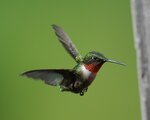With the arrival of the first spring flowers come the first sightings of nature’s pollinators. Bees, butterflies, moths and many other animals can be seen gathering nectar from spring flowers, …
Stay informed about your community and support local independent journalism.
Subscribe to The River Reporter today. click here
This item is available in full to subscribers.
Please log in to continue |

With the arrival of the first spring flowers come the first sightings of nature’s pollinators. Bees, butterflies, moths and many other animals can be seen gathering nectar from spring flowers, cultivated and wild alike.
One pollinator comes very far, having wintered in southern Mexico and Central America. Welcome the return of the ruby-throated hummingbird.
Hummingbirds typically arrive in the region around late April. According to sightings reported for 2023 on Hummingbird Central’s website, sightings occurred in Port Jervis, NY; Shohola, PA; and Eldred, NY, all on the 24th of April.
They start moving from their wintering ground during late winter; first sightings near the U.S. southern border with Mexico and at the Gulf of Mexico usually occur around mid-March.
Ruby-throated hummingbirds conduct their migration, with one notable exception. The bulk of the hummingbirds that we see, and those along the eastern U.S., fly over the Gulf of Mexico to get here. There are no rest stops over the open water of the gulf, so they must continuously fly, day and night, until they reach land.
Before the migration starts, the hummingbirds bulk up; some hummingbirds gain up to 40 percent of their body weight before the migration.
On the way up north, these tiny birds will take rest stops along the way, especially where food is plentiful. Nectar is their mainstay, but hummingbirds will also pick small insects from flowers and sap wells to supplement their diets.
In this region, wildflowers such as jewelweed and cardinal flower will attract hummingbirds. In the garden, there are a variety of tubular flowers that attract them. If you use a hummingbird feeder, mix 1 part sugar to 4 parts water and do not add red dye or anything else.
There is a lot of information on hummingbird feeders, plus other facts about this species—including real-timer migration maps—at www.hummingbirdcentral.com.
Comments
No comments on this item Please log in to comment by clicking here